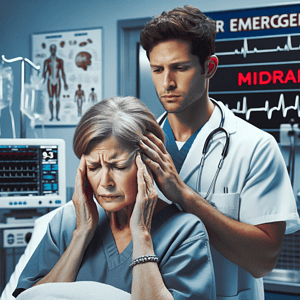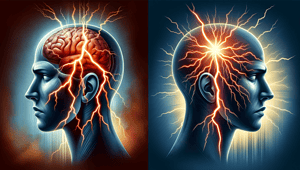What is a Migraine?
Migraines are severe recurring headaches that can be accompanied by other debilitating symptoms. Unlike a normal headache, migraines typically involve throbbing pain on one side of the head along with nausea, vomiting, sensitivity to light and sound, blurred vision, tingling, and more. Migraine attacks can last anywhere from 4 to 72 hours when untreated.
While migraines are usually manageable at home, it’s important to know when to seek emergency care. Sudden changes in headache patterns or severity, concerning neurological symptoms, and other warning signs can indicate dangerous underlying medical conditions requiring urgent evaluation.

Recognizing Symptoms that Require an ER Visit
Sudden Onset or Change in Headache Patterns
If you suddenly develop the worst headache of your life or experience significant changes in the intensity or duration of your usual migraines, this signals the need for emergency care. Specific warning signs include:
- Thunderclap headaches – Headaches reaching peak intensity within minutes, especially in those over 50, can indicate bleeding or blood clots in the brain. Seek ER care immediately.
- Headaches unlike your normal migraines – Sudden differences in location, severity, duration, or associated symptoms likely mean something more serious is happening. Don’t wait – go straight to the ER.
Concerning Neurological Symptoms
Numbness, confusion, vision issues, and other neurological symptomsDemand urgent medical care if you experience:
- Fever over 101°F (38.3°C) – Fever with headache can indicate meningitis, encephalitis, or brain infections requiring emergency treatment.
- Neck stiffness – Stiffness alongside migraine heightens concerns of meningitis and related infections.
- Mental confusion, seizures, loss of consciousness – Any altered awareness, convulsions, or unresponsiveness means a trip to the ER.
- Vision loss, double vision, intense vertigo – Sudden vision changes or dizziness can warn of stroke or blood flow issues in the brain needing urgent intervention.
- Numbness, weakness on one side of the body – Focal neurological deficits like one-sided numbness/weakness are red flags for stroke even with mild headaches.
- Trouble speaking or swallowing – Slurred speech, garbled words, or difficulty swallowing all require emergency medical help.
Other Severe Symptoms
Seek emergency care immediately if you experience:
- Nonstop vomiting – Unrelenting nausea/vomiting can lead to dangerous dehydration and electrolyte problems.
- Migraine attack lasting over 72 hours – Most last under 72 hours; persistent headaches likely involve secondary causes needing evaluation.
- Sudden new migraine symptoms – First migraine ever or suddenly different symptoms compared to your normal migraines warrant an ER visit.
- Complications during pregnancy – Pregnant women with severe headaches, especially with other concerning symptoms, need emergency assessment.
- Underlying health conditions – Those with heart disease, autoimmune disorders, or other medical issues should seek emergency care for severe migraines.
Differentiating Between ER and Urgent Care
Since severe migraine symptoms mimic urgent medical emergencies like stroke, prioritize the ER over urgent care, especially if you have:
- Any warning signs described above
- Uncontrolled pain despite home treatment
- Concerns about underlying medical conditions
However, urgent care may be appropriate for:
- Migraines not responding to usual medications
- Seeking stronger prescription pain/anti-nausea medication
- Wanting professional advice on managing persistent headaches
When to Seek Care Regardless of Severity
While severe, sudden symptoms clearly warrant an ER visit, other situations require medical evaluation regardless of migraine intensity. Seek prompt care if you have:
- Your first migraine ever – Sudden onset in adulthood needs assessment to rule out secondary causes.
- Significantly different migraine symptoms – Changes in patterns, especially with concerning new neurological symptoms, necessitate medical review.
- Fever or body rash during migraine – Fever and rashes may indicate infections requiring diagnosis and treatment.
- Concerns about medication issues – Discuss any medication questions or worries about side effects/interactions.
- Worsening pain or no improvement after 24 hours – Most migraines improve within 24 hours; persistent or worsening pain suggests an underlying medical issue.
When to Go to the Hospital: Key Takeaways
Living with migraines involves balancing self-care while recognizing when to seek emergency intervention. Watch for sudden, severe symptoms and don’t ignore warning signs something more dangerous may be happening. Trust your instincts – you know your body best.
While home remedies can alleviate many migraine attacks, urgent diagnosis and treatment early on can prevent complications and dramatically improve pain management. Don’t hesitate to go to the ER if your symptoms are severe or fit any of the warning signs covered here – early intervention makes a difference.
Just as importantly, establish ongoing care with a doctor familiar with your medical history. Keep them updated on your evolving symptoms, ask questions about any concerning changes, and work together to customize an effective treatment plan for your situation.
When living with chronic migraines, being proactive by knowing emergency red flags, seeking timely medical intervention when appropriate, and prioritizing continual care provides the best chance of effectively managing your pain long-term.



